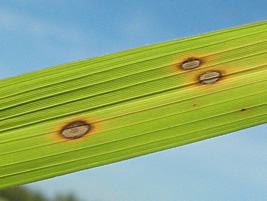Brown spot is a disease caused by fungi of the genus Bipolaris and primarily infects grasses. Brown spot is cosmopolitan and, while challenging in many places, seems to have a tendency to prefer subtropical to tropical climates, which are typically mild and humid. This is evident in regions like southern South America, parts of Australia, South Africa, and the southern United States. These fungi cause damage in rice, palms, grasses, sunflower, corn, coconut, lupine, pandanus, maranta, heliconia, ti plant, cacti, dragon fruit, confetti, dahlia, among many other plants. Thus, the disease is not limited to crop plants, also affecting numerous species of ornamental plants. Infections are often more pronounced and severe in tropical regions, where they can damage entire crops and lead to famine in local populations. Its potency was such that it was even considered as a biological weapon by the USA against Japan during World War II.
The Bengal Famine of 1943 is a tragic example of the devastating impact of brown spot on food security. During this period, the Bengal region in British India suffered one of the worst famines in its history. A major culprit was the brown spot disease in rice, caused by the fungus Cochliobolus miyabeanus (anamorph as Bipolaris oryzae). This disease attacked rice crops, significantly reducing agricultural yields in a region already affected by economic and political difficulties. It is estimated that rice production fell by 40% to 90% in some areas, exacerbating food shortages and directly contributing to the famine that led to the death of approximately 2 million people.
The lesions of Bipolaris, especially in grasses, are typically dark brown spots on leaves, stems, and grains, most commonly found on leaves. These spots are circular, oval, or elliptical, with a lighter, grayish center resembling dry necrosis. Surrounding the spots is a characteristic light yellow halo. In extreme cases, the spots can cover up to half of the leaf area. As they grow and spread, they coalesce to form larger spots.
Infections mainly occur during germination and flowering and are difficult to control. Moreover, the fungus causing brown spot can produce toxins that inhibit the development of roots, shoots, and leaves, and also reduce the plants’ defense capabilities. This mode of action is one of the main causes of the brown spots that form on leaves, a classic symptom of infection.
The dispersion of these fungi primarily occurs due to wind action and, to a lesser extent, through infected seeds and seedlings. Additionally, over short distances, raindrops and/or irrigation can act as a means of transporting spores, infecting plants near the initial focus. In general, the favorable conditions for the development of these fungi are mild temperatures combined with high relative humidity and frequent wetting. Furthermore, plants with nutritional or water deficiencies are more prone to illness. Excess nitrogen tends to favor the disease, while corrective applications of calcium, potassium, and silicon improve plant resistance.
In grasses, such as rice and corn, and even in ornamental grasses, this disease is favored by conditions of low humidity and high temperatures, environments common in regions with dry periods. On the other hand, the disease in cacti, mainly caused by Bipolaris cactivora, presents a different dynamic. This pathogen thrives in warm and humid environments, conditions often found in greenhouses or in tropical and subtropical regions. The infection typically manifests as stem and fruit rot, especially in pitaya. In cacti, the initial symptoms are yellowish, water-soaked lesions, progressing to extensive areas of rot that can lead to the death of the plant.
Prevention of brown spot includes strict control of plants added to the nursery, garden, or collection. A quarantine period is essential to prevent the entry of the disease. Keeping plants healthy, with balanced nutrition, and well hydrated is also important to avoid the onset of brown spot. Cleaning in the beds and production areas is also crucial, avoiding leaving pruning residues and grass clippings accumulated, as well as weeds that may serve as hosts for the disease. The appearance of brown spot is often an indicator that irrigation is misadjusted, either due to excess water or a frequency above the recommended level.
Control is carried out with the application of fungicides, such as Bordeaux mixture, but never curatively, always preventively, since high infections are practically impossible to control. In small crops or ornamental gardens, it is mainly recommended to take actions to prevent the establishment and spread of the disease, such as acquiring disease-free seeds, seedlings, and adult plants from reliable traders and preferring species, varieties, and cultivars, if available, with known tolerance to the disease.
Furthermore, maintaining pruned plants to ensure ventilation and prevent irrigation water from remaining pooled on the leaves, regulating both temperature and humidity, is crucial. Irrigation should, whenever possible, be carried out on the soil or substrate and not on the leaves. Additionally, it cannot be overstressed how much nutrition affects plant physiology. When well-nourished, plants generally have more efficient defenses against pathogens like Bipolaris, as well as pests.
When plants with symptoms of brown spot are found, the application of fungicides is recommended. It is crucial to vary the products used, alternating between materials with different modes of action. This can be done by consulting an agronomist who will recommend alternating between contact fungicides like chlorothalonil, copper, or mancozeb, with those of the FRAC 3 and 11 Groups, such as triazoles and ubiquinol oxidase. Even if you find an effective product, this is an efficient strategy to prevent the emergence of resistance. Some high-value plants can be recovered with pruning and systemic fungicides when applied in time. Consider that the fungus spores spread easily through the air and water. Burn without hesitation the pruning remains of affected plants, as well as plants that are irreversibly afflicted.
It is also fundamental that producers and nursery owners are careful in detecting the first signs of diseases in their plants, thus avoiding the spread of diseases through intermediaries, retailers, and customers.


